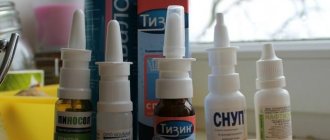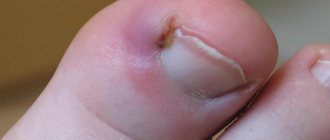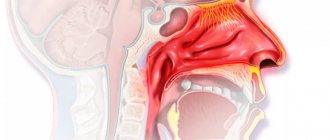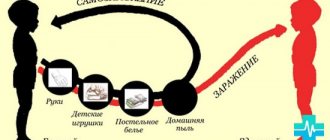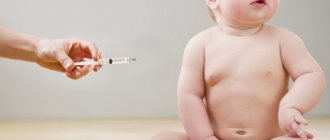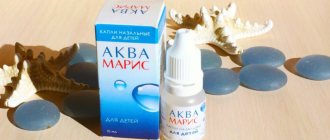Why does atopic dermatitis appear less often in adults than in children?
Atopic dermatitis (otherwise “atopic eczema”) is a chronic allergic dermatitis that has a relapsing course. Characterized by rashes accompanied by itching and dry skin. Translated, “atopy” means “strangeness”, “abnormality”. Since the true cause of the disease is often unknown, this name is fully justified.
In 90% of cases, atopic dermatitis in children appears before the age of 2 years, since during this period the baby’s immune system is still imperfect and reacts sharply even to harmless substances. In most cases, the disease ceases to manifest itself as soon as the child matures. Atopic dermatitis in adults can “dormant” in the body, worsening when allergens appear.
Causes of atopic dermatitis in children
Heredity is one of the main factors in the development of atopic dermatitis in children. If one of the parents suffers from a tendency to allergies, atopic bronchial asthma and some other atypical reactions of the body, the likelihood that the child will develop diathesis, allergic dermatitis or eczema is about 50%. Moreover, if both parents are sick, the possibility of transmitting the disease by inheritance is approximately 80%. But even if both the mother and father of the baby are healthy and do not have allergic problems, this cannot be considered one hundred percent protection: even in such cases, the probability of developing atopic dermatitis reaches 20%.
Another reason for the appearance of atopic dermatitis is the insufficient level of development of the child’s gastrointestinal tract. Once entering the body, nutrients cannot be completely digested by its fragile digestive organs, as a result of which incompletely broken down food accumulates in the intestines. In addition, many parents openly overfeed their babies. Excess food is undigested due to a lack of appropriate enzymes, and its breakdown products enter the blood, causing the development of atopic dermatitis.
Features of the development of the immune system also play an important role in the formation of a tendency to atopic dermatitis in children (the development of atopic dermatitis is based on immune-dependent inflammation). After all, the symptoms of the disease are caused by, in general, completely harmless substances. In many children, atopic dermatitis goes away over time precisely because of this. That their immunity begins to “work” better with age.
Place of residence also plays a role. It is believed that children living in large cities are more susceptible to atopic dermatitis compared to those living in rural areas.
Causes of allergic dermatitis
Symptoms of the disease, such as rashes, peeling, and skin irritation, can occur as a result of a “response” to inhaling something or touching something. Depending on the route of penetration of the allergen into the body of children, the allergic reaction will be called respiratory, contact or food.
- If dermatitis occurs due to the penetration of some allergen through the skin, then this refers to a contact allergy. (The provoking factor could be, for example, synthetic fabric).
- If children are diagnosed with respiratory allergies, then the risk factor could be powder, any cleaning or detergent, plant pollen, or household dust. The child simply inhaled an allergen, which triggered the development of allergic dermatitis.
- If an allergy begins to develop on the skin as a result of consuming one or another product that can provoke an illness, then the baby has a food allergy.
Please note that the disease allergic dermatitis has other names. You can often hear terms such as childhood eczema and atopic dermatitis.
Atopic dermatitis in children: symptoms
The main signs of atopic dermatitis in children are:
- severe itching of the skin;
- small rashes in the form of pimples, localized mainly on the neck, cheeks, popliteal, elbow and armpit cavities, as well as in the groin area, on the buttocks, head and near the ears;
- pain when touching the rash;
- hyperemia of the skin in areas of the rash, adjacent to general pallor;
- the formation of weeping erosions after breaking the integrity of a pimple;
- the appearance of dry crusts after the wetness has dried;
- strengthening of the skin pattern, possible thickening of the skin.
Possible complications
Incorrect or untimely treatment of atopic dermatitis in children can lead to the development of serious complications, which, in turn, are divided into systemic and local. Systemic complications include:
- psychological disorder;
- hives;
- bronchial asthma;
- allergic form of conjunctivitis and rhinitis;
- the development of lymphadenopathy - a pathology that is accompanied by enlargement of the lymph nodes.
Complications of atopic dermatitis in children
Local complications of atopic dermatitis in children include:
- lichenification of the skin;
- development of a viral infection (as a rule, patients develop herpetic or papillomatous lesions);
- candidiasis, dermatophytosis and other fungal infections;
- infectious inflammation accompanied by pyoderma.
To avoid such complications, the disease must be treated in a timely manner, so at the first suspicious symptoms, the child should be shown to a doctor as soon as possible.
Atopic dermatitis in children: treatment
Unfortunately, it is impossible to completely cure atopic dermatitis in children. Its symptoms may go away on their own as they grow older, or they may remain latent and manifest themselves from time to time. In any case, everything possible must be done to reduce the signs of atopic dermatitis, control its course and minimize exacerbations. How to treat dermatitis depends on the causes and form of its manifestation. So, if you notice skin dermatitis in a child, do not be afraid, but think about what could be causing the irritation.
Make an appointment with your pediatrician as soon as possible, who will answer your questions and tell you how to treat atopic dermatitis in your child. It is likely that the pediatrician will immediately prescribe appropriate treatment, but in some more complex cases, additional consultation with an allergist, dermatologist, gastroenterologist, nutritionist and psychologist may be required. It is also possible to conduct skin tests or tests - they will help establish a more accurate diagnosis. These can be skin prick tests, prick tests, provocative tests, as well as tests to determine the concentration of total IgE and to determine allergen-specific IgE-AT in blood serum.
Actions aimed at accelerating recovery involve more than just managing symptoms when treating atopic dermatitis in children. It is also extremely important to have a beneficial effect on the underlying problems that caused the development of an atypical reaction of the body. For this reason, treatment should be comprehensive - pathogenetic and symptomatic. An important role in the treatment of atopic dermatitis in children is also given to the competent selection of care products to moisturize, cleanse and nourish damaged skin.
The following groups of medications are usually used to treat atopic dermatitis in children:
- Antihistamines and antipruritics. Among antihistamines for the treatment of atopic dermatitis in children, 2nd and 3rd generation drugs are especially popular: Zyrtec, Claritin.
- Anti-inflammatory. If a child scratches the rash and gets infected, there is a high probability that an inflammatory process will begin. To reduce its manifestations, your doctor may prescribe anti-inflammatory drugs.
- Antimicrobial. The use of antimicrobial drugs is justified if there is a risk of infection, fungi and other pathogens entering the scratching area.
- Enterosorbents. Drugs in this group help remove toxins from the body that have entered the bloodstream, as a result of which the general symptoms of atopic dermatitis are reduced. The most commonly prescribed medications are activated carbon, Enterosgel, and Smecta.
- Medicines to improve intestinal and liver function. Improving intestinal microflora, eliminating possible dysbacteriosis, as well as taking choleretic enzymes - all these actions help normalize the functions of the gastrointestinal tract, which have become one of the causes of the development of atopic dermatitis.
External therapy for dermatitis is reduced to the use of corticosteroid (hormonal) and non-hormonal drugs. The choice of remedy should be made by the doctor, taking into account the intensity of the symptoms, age and general condition of the small patient.
Hormonal drugs provide quick relief, as their effect is more pronounced. They are usually prescribed in cases where it is important to eliminate the itching of atopic dermatitis as soon as possible, which interferes with normal functioning, rest and sleep, as well as in cases where the use of non-hormonal ointments and creams does not give the desired result.
It is important to remember that corticosteroid ointments and creams should be used exclusively during periods of exacerbation and progression of atopic dermatitis. In this case, it is necessary to strictly adhere to the dosage prescribed by the doctor and not to spontaneously increase the duration of treatment with hormonal local agents. The dose should be reduced gradually.
Non-hormonal ointments and creams are considered less hazardous to health and can therefore be used for a long time. They can be used during periods of attenuation of symptoms of atopic dermatitis.
Cream for atopic dermatitis in children
Compared to ointment, cream has a lighter structure. Most often, creams for atopic dermatitis in children are made on a hydrophilic basis; they are easily absorbed and provide sufficient hydration. Creams are mainly used in the presence of weeping erosions.
Ointment for atopic dermatitis in children
Ointments have a denser and greasy structure than creams. When applied, a thin film is formed on the skin, which softens dry areas well, but may interfere with sufficient hydration. Such products penetrate deep into the skin, so they are usually prescribed for dryness and cracks in atopic dermatitis.
Diet for atopic dermatitis in children
As mentioned above, one of the reasons for the appearance of atopic dermatitis in children is the insufficient development of their gastrointestinal tract. Eating inappropriate foods causes an allergic reaction, resulting in symptoms of the disease. It is for this reason that correcting a child’s nutrition with atopic dermatitis is one of the primary tasks. However, one must take into account the fact that at the moment there is no universal nutrition system suitable for all children suffering from dermatitis. Therefore, compiling a list of permitted and prohibited foods should be done by a pediatrician, gastroenterologist or nutritionist - and this should be done based on the results of tests and skin tests.
One thing is clear: the menu for a child with atopic dermatitis should be as gentle as possible. If the baby is breastfed, the same applies to the mother's diet.
Typically, the doctor recommends eliminating products that contain artificial colors, thickeners, sweeteners, stabilizers, preservatives, antioxidants, emulsifiers, leavening agents and other chemical additives. During the treatment of atopic dermatitis, it would be useful to avoid smoked foods, salted, fried and spicy foods, ketchups, cereals, mayonnaise, cow's milk and other dairy products, chicken eggs, nuts, fish and seafood, chocolate, and baked goods.
Sweets, buns and other sweets deserve special attention. Despite the fact that they belong to the category of carbohydrate foods, and allergies are usually caused by proteins, it is still necessary to avoid sweets during the treatment of atopic dermatitis. Sugar contained in sweet foods increases fermentation processes in the intestines, resulting in increased symptoms of dermatitis.
The adjusted menu can be further enriched by including small portions of fish oil (if the child is not allergic to it) or evening primrose oil. It is important not to limit the amount of fluid consumed, since toxins will be eliminated from the body along with urine. In some cases, the doctor may recommend resorting to therapeutic fasting.
Treatment methods
The main goal of therapy for atopic dermatitis in children is to desensitize the body, limit provoking factors, eliminate symptoms and prevent the development of serious complications or exacerbations of the pathology. Complex therapy should include taking medications (the use of local and systemic drugs), following a special diet, as well as traditional medicine.
Goals of treatment for atopic dermatitis in children
Pharmacy drugs
To relieve the symptoms of atopic dermatitis, the child may be prescribed the following groups of drugs:
Goals of external therapy for atopic dermatitis in children
- antihistamines – have antipruritic properties. Such products as “Zodak”, “Cetrin” and “Finistil” are used;
- antibiotics - prescribed in cases where the disease is accompanied by a bacterial infection (Differin, Levomikol, Bactroban and others);
- antimycotics and antivirals are required when diagnosing additional infections. If a viral infection occurs, the doctor may prescribe Gossypol or Alpizarin, and if a fungal infection develops, Nizoral, Pimafucin, Candide, etc. are used;
- immunomodulators - used for atopic dermatitis, if signs of immune deficiency have been added to the symptoms of the pathology. These are potent drugs, so only the attending physician should select them;
- drugs to normalize the functioning of the gastrointestinal tract;
- Glucocorticosteroids are steroid hormones designed to eliminate pronounced symptoms of dermatitis. They are used in rare cases due to the large number of contraindications and side effects.
Drugs for atopic dermatitis in children
To speed up the regenerative functions of the body and restore affected areas of the skin, the doctor may prescribe special ointments that stimulate regeneration. The most effective drug is Panthenol.
Nutrition
Komarovsky works hard on the topic of treating atopic dermatitis in children . He recommends organizing nutrition when the child's diagnosis is confirmed (see nutrition for seborrheic dermatitis). This will speed up the healing process and prevent recurrence of the disease.
Diet for a child with atopic dermatitis in children
To do this, you should follow a few simple nutritional rules:
- do not overfeed the child, because this will lead to disruption of metabolic functions, which is fraught not only with obesity, but also with the development of skin diseases;
- Reduce the fat content of breast milk if possible. To do this, a nursing mother must also follow a special diet, do not overeat fatty foods and drink enough fluids;
- When feeding a baby, you need to make a small hole in the nipple, thereby slowing down this process. This manipulation promotes normal digestion of food.
Features of diet therapy for atopic dermatitis in children
Komarovsky also advises maintaining the room temperature no more than 20C. This will reduce the level of sweating in the child.
Folk remedies
If the disease was diagnosed in a child over 3 years old, then many parents use traditional medicine as therapy, which are in no way inferior in effectiveness to synthetic drugs. But before using them, you should definitely consult with your doctor.
Diaper dermatitis in children - how to treat the little ones?
One of the most common and early ailments in a child under 1 year of age is atopic diaper dermatitis. Irritation appears on the butt and in the groin area - that is, in places that come into contact with diapers or diapers. Most often, diaper dermatitis occurs when diapers are not changed on time. The skin cannot breathe, plus it is affected by aggressive substances from excretory products. This is how swelling, peeling, redness and itching appear. The best remedy for diaper dermatitis is to give your baby air baths, wash him more often, use powders for weeping irritations and creams for dry ones.
Folk remedies for the treatment of atopic dermatitis in children
In addition to therapy for dermatitis prescribed by a doctor, the use of traditional medicine advice is justified. However, you should not use them as the main treatment: “grandmother’s” recipes can only act as additional treatment. Moreover, it is important to consult with your doctor regarding their appropriateness and effectiveness.
The following agents act as active ingredients used in traditional medicine recipes for the treatment of atopic dermatitis in children:
- Celandine juice. Fresh leaves and stems of the plant are washed and ground in a blender/meat grinder, after which the pulp is drained through cheesecloth. Celandine juice is mixed with purified water in a ratio of 1 to 2, clean gauze or bandage is moistened in the resulting composition and applied to the rash for a quarter of an hour.
- A series. The series has pronounced anti-allergenic properties, therefore it is widely used for the treatment of atopic dermatitis. Decoctions and infusions are prepared from it for applications and compresses, and are also added to baths.
- Tar. Tar soap is known for its drying properties, so it can only be used in the presence of weeping erosions, characteristic of the initial stage of atopic dermatitis in children. If your skin is extremely dry, it should not be used.
- Tea tree oil. This oil is characterized by anti-inflammatory, antimicrobial and drying effects. Used externally in case of weeping.
Prevention of atopic dermatitis in children
Since it is impossible to completely eliminate the manifestations of atopic dermatitis in children, it is important to know the basic principles of preventing this disease. If you follow these recommendations, you can reduce the frequency and intensity of exacerbations.
To reduce the allergic reaction, it is necessary, first of all, to identify and remove the irritating substance.
There is a general rule for caring for skin affected by dermatitis: we dry wet areas with special lotions and drying creams, and nourish dry areas with oils and ointments.
The duration of water procedures for atopic dermatitis should be kept to a minimum - it is recommended to swim and shower for no more than 5-10 minutes. The water temperature should be moderate - neither hot nor cold. At the same time, it is advisable to reduce the use of chlorinated tap water: if possible, it is better to install a reverse osmosis filter or boil the water and use it after cooling. Also, to prevent dermatitis, it makes sense to abandon frequent washing and rinsing in favor of using hypoallergenic wet wipes. The same applies to washing with a hard washcloth - it should be replaced with a soft sponge or mitten made from a terry towel.
It is recommended to wear clothes made from natural materials - cotton, linen, flannel, bamboo. At the same time, it should be spacious enough to reduce contact with the skin, possible chafing and irritation.
It is advisable to stop using conventional washing powders and fabric softeners, replacing them with hypoallergenic eco-products - soapwort root, soap nuts or specialized powders. This is important to do because microparticles of products are usually not rinsed out completely, remaining on clothes and bedding, which leads to exacerbations of atopic dermatitis in children.
The room must have sufficient air humidity and a relatively cool temperature - this requirement is especially important to comply with in the autumn-winter period, when central heating systems are operating. To normalize humidity levels, it is recommended to use a household humidifier or place bowls of water around the house. To control the temperature, it is recommended to use an air conditioner. It would be a good idea to get rid of places where dust accumulates - carpets, and carry out wet cleaning daily.
It is important to protect the child from stressful situations and normalize his sleep. All psycho-emotional stress should be kept to a minimum.
To prevent a small child from scratching the skin affected by atopic dermatitis, you can put cotton mittens on him. It is also important to ensure that your baby's nails are always short and clean - this will help prevent infections from getting into the combs if the child scratches the rash.
It is advisable to avoid excessive sweating caused by active physical activities - sports exercises and excessively active games.
It is necessary to reduce the time spent in the sun and not sunbathe during the period of greatest solar activity - from 10 to 17 hours. When going outside during the heat, you should use sunscreen spray or cream.
In the presence of atopic dermatitis, it is necessary to carefully select skincare and hygiene products. You will have to give up alcohol-based lotions, soaps and shampoos with aggressive ingredients. Preference should be given to products with a neutral pH level that do not contain fragrances or dyes.
It will be useful to at least temporarily change the climate to a drier and warmer one, of course, after consulting with your doctor first. For example, many parents note a decrease in the symptoms of atopic dermatitis in children at sea, and during long stays (up to several years) in coastal resort areas, cases of almost complete cessation of exacerbations have been observed.
Not by bread alone...
To stop sinning with food, you need to understand how skin damage occurs. And first of all, how the skin works. In the upper (horny) layer of the skin we have a special lipid barrier that protects our skin from the penetration of harmful factors from the outside into its depths, as well as an extremely important layer consisting of water molecules that are held in the skin by a special substance (essentially a complex of organic molecules ). Water molecules in the skin provide its elasticity, firmness and additionally protect it from external harmful factors.
If a child spends most of his time indoors with a warm and dry microclimate, if he is constantly dressed in cabbage style, or if his clothes contain unnatural irritating fibers, all this leads to excessive evaporation of moisture from the skin, destruction of the lipid barrier and , accordingly, to extreme vulnerability. As a result, the skin becomes dry and hypersensitive. This means it is too “open” to attack by harmful external factors: allergens, toxins, various chemicals, pollution, bacteria and fungi, etc.
At the slightest inflammation, microscopic bubbles form in sensitive skin, which over time burst and become crusty - they cause severe unbearable itching, which intensifies many times at night, during sleep.
How to treat atopic dermatitis using La-Cri products?
La-Cri products gently care for affected skin, reducing redness and flaking, and relieving itching. The effectiveness of all products in this line is based on the action of natural ingredients that help treat dermatitis. These are extracts of string, violet, walnut and avocado, panthenol and bisabolol - together they provide comprehensive care for skin prone to dryness and rashes.
With atopic dermatitis, when rashes appear, the skin dries, flakes and cracks, it will help to nourish and soothe the inflamed skin.
Clinical researches
La-Cri creams for sensitive skin and La-Cri cream for dry skin are recommended by the St. Petersburg branch of the Union of Pediatricians of Russia.
The conducted clinical study proves the high efficiency, safety and tolerability of the product for daily skin care of children with mild and moderate forms of atopic dermatitis and during remission, accompanied by a decrease in the quality of life of patients. As a result of therapy, a decrease in the activity of the inflammatory process, a decrease in dryness, itching and flaking was noted.
Consumer Reviews
Mvikki (irecommend.ru)
“I think it will be good for summer. I have already written about skin creams several times. Here you can read about some that I have personally used.
Let me remind you that my skin is dry, especially in winter. I use creams and body lotion every other day, immediately after the shower, while the skin is steamed. La Cree purchased this product while she was in Siberia. Since winter came out of the blue in October, my skin began to flake and itch terribly. I had to somehow save myself from these feelings. La Cree was recommended to me by a pharmacist. Made in Russia and can be used from 0 years old, that is, from birth. According to the manufacturer, the emulsion should moisturize, nourish, soothe the skin and relieve itching and irritation. This is what the packaging looks like
Everything is done in rather calm colors, the price tag has been preserved. Volume 200 ml. The composition contains extracts of string, licorice, walnut; bisabolol and violet extract; d-panthenol and sodium hyaluronate; jojoba oil.
Directions for use: Apply to skin 1-2 times a day. For very dry skin, apply as needed. Apparently I’m just in that category where I need to apply the emulsion often, since the effect was not enough for a long time. The bottle, if you can call it that, is made of plastic and is shaped like a shampoo container. Doesn't slip in your hands. The emulsion is white, light texture, herbal smell.
After application it is absorbed very quickly, there is no feeling of film or greasy shine. As I wrote above, I apply the emulsion immediately after a shower, this is what I did when I was in Siberia. But literally after a couple of hours the skin was again tight and unpleasantly peeling. I was disappointed, I wanted to rate the product 2. Then I ended up in Central Russia and applied it here, and I was very surprised that I could walk calmly for a day without any unpleasant skin sensations. I don’t know why everything is so different, maybe it’s the climate or the water is different. I think this emulsion will be ideal for normal skin prone to dryness, but for very dry skin it is better to put it aside for the summer. Thank you for your attention".
tararkova (irecommend.ru)
“A magical emulsion for your skin. Good day everyone.
During the period of breastfeeding, I developed an allergy, which was accompanied by itching and flaking of the skin, and since most medications were prohibited, the dermatologist recommended several moisturizers to choose from, from which I chose La-Cri Emulsion. I have never met this company, and most likely would not have paid attention to it if not for chance.
The emulsion is white, a little runny, every time I use it, more product comes out than needed, so its dispenser is not convenient. Its aroma is not very pleasant, but not annoying.
At first I applied this Emulsion only to areas with allergies, and then I began to apply it to my face, since with its help I got rid of the symptoms of the disease in just a few days. This emulsion perfectly moisturizes and nourishes, relieves itching and irritation. There were no negative consequences after it. I recommend this Emulsion, I give it 5 stars, despite the inconvenient dispenser.”
Sources:
- B.A. Shamov, I.G. Safiullina, A.B. Beshimova, T.B. Shamov, Differential diagnosis of atopic dermatitis, journal of Practical Medicine, 2011 https://cyberleninka.ru/article/v/differentsialnaya-diagnostika-atopicheskogo-dermatita
- Fokina R.A., Atopic dermatitis: stages of development of classification forms, Siberian Medical Journal, 2007 https://cyberleninka.ru/article/v/atopicheskiy-dermatit-etapy-razvitiya-klassifikatsionnyh-form
- Smirnova G.I. Atopic dermatitis and skin infections in children, Russian pediatric journal, 2014 https://cyberleninka.ru/article/v/atopicheskiy-dermatit-i-infektsii-kozhi-u-detey
Photos of dermatitis
Allergy or atopic dermatitis: how to find out
Typical situation: the first signs (rash, itching, redness on the skin) appeared in the baby during the introduction of the first complementary foods - about 6-8 months. You, parents, and perhaps pediatricians who are observing your child, logically concluded that there are manifestations of food allergies - some new foods are perceived extremely negatively by the baby’s body. And gradually you remove everything bright from the child’s diet: first, everything is bright, then everything is colorful, and then, perhaps, valuable protein in the form of milk and eggs, etc. Sometimes the situation goes off scale to the extreme, leaving only rice porridge and dried apples in the diet of the unfortunate child...
However, outbreaks of redness and rashes on the skin still occur from time to time. You are guilty of the fact that the baby somewhere “snatched” a piece of a forbidden product, which caused an exacerbation of the disease.
But in fact, periodic deterioration in the condition of the skin shows you something completely different - this is a clear signal that you still have not removed the main “causative agent of skin disturbance” from the child’s environment. And that, most likely, we are talking not so much about food allergies, but about atopic dermatitis, the “causative agent” of which foods are extremely rare. Why? We'll explain a bit below.
Well-known children's doctor, Dr. Komarovsky: “This is a typical common misconception - that an exacerbation of atopic dermatitis occurs in response to certain foods eaten. In fact, there is no fundamental connection between atopic dermatitis and the quality (composition) of products."
Indeed, in response to some products, an allergic reaction of the body may occur with symptoms similar to those of atopic dermatitis: itching, redness and rash on the skin. However, symptoms of such an allergy should appear within a maximum of the first 24 hours from the moment the product was eaten. But if the rash and itching appeared two days after your Mitya, relatively speaking, ate peanuts, then it’s not the peanuts at all! And it’s not an allergy to the face, but atomic dermatitis.
Dr. Komarovsky: “In 85% of cases of itching and eczema on the skin in children under 2 years of age (and most often in children from 6 months to a year), this is not an allergy to certain foods that a child has eaten or a nursing mother has eaten, and nothing more than atopic dermatitis, which has nothing to do with food.”


